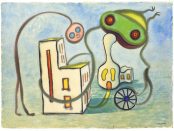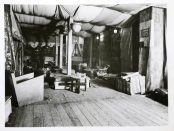[dropcap style=”font-size:100px; color:#992211;”]T[/dropcap]he era of media production has reached a knowing end of innocence.
The naïve and perhaps innocent flair of work created in the ’60s and ’70s seems to have exhausted itself culturally. The almost flippant monolithic nature of those large pronouncements seems impossibly innocent to us. That you could work in advertising and consider yourself commercially unsullied beggars belief now, however, those of that era impart the sense (perhaps with a wry but knowing wink) that its wasn’t all about bums on vinyl seats. There was a sense of magnitude to the work they created, Moreover, there was a sense of continuation from their creative endeavours to what paid the bills more regularly.
For photographers of the Sixties this was a chance to chronicle an era self-consciously changing. An era eager to exorcise the innocence and evils that casually permeated their lives as sexism, racism, and conservative hegemony. It was a time to swing and go with the wild. A photographer framing this change was John Claridge.
Despite having no formal training, at age 15 he started working at McCann Erickson advertising agency in their design and photography department and staged his first exhibition at 16: a study of London’s East End. Despite being a photographer with sharp commercial acumen and a strong aesthetic compositional sense, there has always been a wildly human, almost existential, quality to his work. A lifelong fan of jazz (his original studio was above Ronnie Scott’s Jazz Club) Claridge’s portraits of legendary musicians and other free Soho characters remain hugely popular. Of particular note are his photos of Tommy Cooper and Ken Russell at the National Portrait Gallery’s extended collection.
Speaking to Trebuchet, he discusses his process, the signature Sabattier-esque finish to his photos, and what of that boomer era that he has carried with him.
Any work of art is a self-portrait?
John Claridge: For me, any artwork is a self-portrait or, at least, a facet of it. Instinctively I react to any subject, be it landscape, documentary, still life or portrait. There are no rules.I mean, there are really no secrets. It’s very simple that each person has a different face and it’s just where the light is falling and the light falls off. That’s all it is. And, also, your expression changes in small ways.
You know, I don’t think that’s the thing. I don’t look for it, these things happen. And, you know, this is just instinctive. If it’s right for me, it’s as natural as breathing.
All that conceptual stuff I’ve heard is good, I suppose, but it’s when you let things go that things happen. Everything is changing all the time so you can’t plan exactly you know? I’ve never been someone that is attached this or that equipment, or even technique or whatever. It’s about the moment. Everything is constantly changing and it should, otherwise it falls into a formula. Formula destroys. It means you don’t open the door, and opening the door is what it’s all about.…[Read more]
Read the full article in Trebuchet 7: Portraits

The aim of art is to represent not the outward appearance of things, but their inward significance. – Aristotle



















